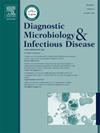Understanding antimicrobial resistance (AMR) mechanisms and advancements in AMR diagnostics
IF 2.1
4区 医学
Q3 INFECTIOUS DISEASES
Diagnostic microbiology and infectious disease
Pub Date : 2025-06-16
DOI:10.1016/j.diagmicrobio.2025.116949
引用次数: 0
Abstract
The overuse and abuse of antibiotics, which results in the evolution of resistant microorganisms, is the primary cause of the global health catastrophe known as antimicrobial resistance (AMR). The enzymatic breakdown of antibiotics, target site modification, efflux pump overexpression, and the formation of biofilm are some of the mechanisms responsible for acquiring antimicrobial resistance (AMR). These mechanisms enable bacteria to evade or neutralize the effects of antimicrobial agents, complicating treatment options and increasing mortality rates. The rapid dissemination of resistance genes via horizontal gene transfer further exacerbates the problem, necessitating urgent intervention. Advanced AMR diagnostics are transforming the fight against antimicrobial resistance. Biosensors enable rapid, point-of-care detection; Cluster regularly interspaced short palindromic repeat (CRISPR) technologies offer precise identification of resistance genes; and mass spectrometry provides fast, accurate profiling. Automated systems streamline workflows and boost throughput, while flow cytometry delivers real-time, single-cell analysis of phenotypic resistance. Together, these innovations accelerate detection and support targeted antimicrobial stewardship, essential for combating the global AMR threat. This review covers the mechanisms underlying antimicrobial resistance (AMR) and recent advancements in AMR diagnostic technologies.
了解抗菌素耐药性(AMR)机制和AMR诊断的进展
抗生素的过度使用和滥用导致耐药微生物的进化,是被称为抗菌素耐药性(AMR)的全球卫生灾难的主要原因。抗生素的酶解、靶点修饰、外排泵过表达和生物膜的形成是获得抗菌素耐药性的一些机制。这些机制使细菌能够逃避或中和抗菌药物的作用,使治疗方案复杂化并增加死亡率。抗性基因通过水平基因转移的快速传播进一步加剧了问题,需要紧急干预。先进的抗菌素耐药性诊断正在改变对抗抗菌素耐药性的斗争。生物传感器可以实现快速的即时检测;簇规则间隔短回文重复序列(CRISPR)技术提供了精确的抗性基因鉴定;质谱分析提供快速、准确的分析。自动化系统简化了工作流程并提高了吞吐量,而流式细胞术提供了表型抗性的实时单细胞分析。这些创新共同加速了检测和支持有针对性的抗微生物药物管理,对抗击全球抗生素耐药性威胁至关重要。本文综述了抗菌素耐药性(AMR)的机制和AMR诊断技术的最新进展。
本文章由计算机程序翻译,如有差异,请以英文原文为准。
求助全文
约1分钟内获得全文
求助全文
来源期刊
CiteScore
5.30
自引率
3.40%
发文量
149
审稿时长
56 days
期刊介绍:
Diagnostic Microbiology and Infectious Disease keeps you informed of the latest developments in clinical microbiology and the diagnosis and treatment of infectious diseases. Packed with rigorously peer-reviewed articles and studies in bacteriology, immunology, immunoserology, infectious diseases, mycology, parasitology, and virology, the journal examines new procedures, unusual cases, controversial issues, and important new literature. Diagnostic Microbiology and Infectious Disease distinguished independent editorial board, consisting of experts from many medical specialties, ensures you extensive and authoritative coverage.

 求助内容:
求助内容: 应助结果提醒方式:
应助结果提醒方式:


